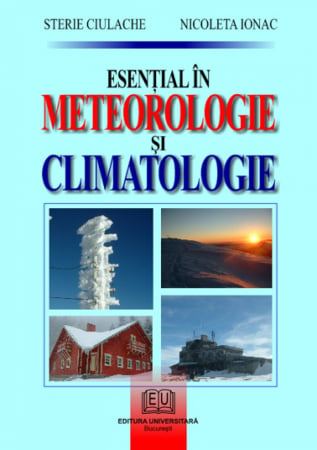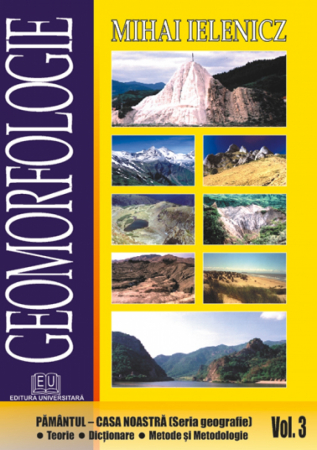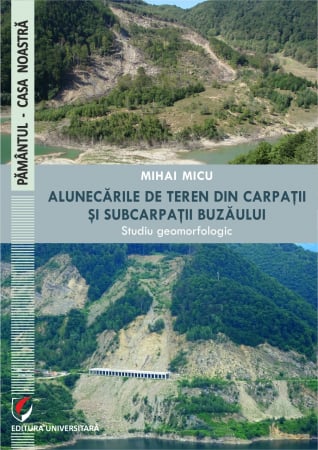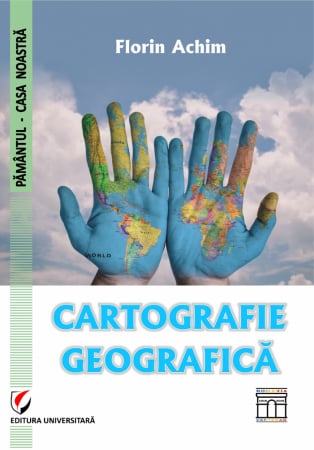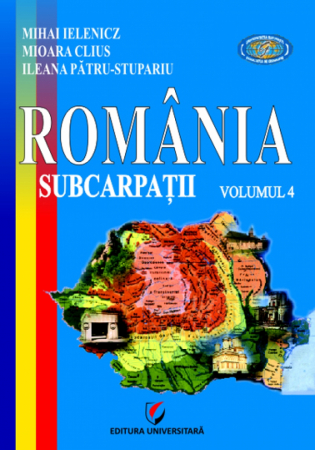Manuscript proposals: [email protected] / 0745 204 115 //// Tracking orders Individuals / Sales: 0745 200 357 / Orders Legal entities: 0721 722 783
ISBN: 978-606-28-0327-8
DOI: 10.5682/9786062803278
Publisher year: 2015
Pages: 160
Publisher: Editura Universitară
Author: Constantin Nitu, Tiberius Tomoiaga
Product Code:
9786062803278
Do you need help?
0745 200 357
- Description
- Download (1)
- Authors
- Content
- More details
- Reviews (0)
This manual is addressed primarily to students of the Faculty of Geography, but also to those who, although they will be users of Geographic Information Systems (GIS), do not have a number of fundamental notions in the field of geodesy.
Although geodesy is a branch of the geomatic sciences with a wide field of coverage, this manual deals only with basic notions, necessary for the correct use of GIS, especially geospatial data.
This paper deals with topics such as:
- the shape of the Earth;
- coordinate and reference systems;
- the role, necessity and way of defining a datum;
- altitude systems (elevations);
- the necessity, the principles and the errors that appear at the transformation of the coordinates between different reference systems (besides the transformation between datums, the particular case of georeferencing is treated briefly);
- GPS positioning principles;
- elementary notions of error theory.
All these elements ensure a minimum of "geodetic" notions necessary for the correct use of geospatial data within a GIS.
The problems related to the networks (geodetic / planimetric, leveling, GPS, magnetism, gravimetric) are treated only in an introductory and descriptive way because the object of activity of the students does not require this knowledge.
This manual has no other role than to guide the "first steps" in the field of geodesy and only enough to correctly understand a series of basic notions without which geospatial data could be used incorrectly in a GIS.
Although geodesy is a branch of the geomatic sciences with a wide field of coverage, this manual deals only with basic notions, necessary for the correct use of GIS, especially geospatial data.
This paper deals with topics such as:
- the shape of the Earth;
- coordinate and reference systems;
- the role, necessity and way of defining a datum;
- altitude systems (elevations);
- the necessity, the principles and the errors that appear at the transformation of the coordinates between different reference systems (besides the transformation between datums, the particular case of georeferencing is treated briefly);
- GPS positioning principles;
- elementary notions of error theory.
All these elements ensure a minimum of "geodetic" notions necessary for the correct use of geospatial data within a GIS.
The problems related to the networks (geodetic / planimetric, leveling, GPS, magnetism, gravimetric) are treated only in an introductory and descriptive way because the object of activity of the students does not require this knowledge.
This manual has no other role than to guide the "first steps" in the field of geodesy and only enough to correctly understand a series of basic notions without which geospatial data could be used incorrectly in a GIS.
-
Geodezia şi Sistemele Informatice Geografice
Download
TIBERIUS TOMOIAGA
CONSTANTIN NITU
CONSTANTIN NITU
CHAPTER 1: INTRODUCTION / 11
1.1 Geodesy / 11
1.2 Brief history of / 12
1.3 Why is geodesy necessary? / 14
CHAPTER 2: DIMENSIONS AND SHAPE OF THE EARTH. SPHERE. THE ELIPSOID. THE GEOID. VERTICAL DEVIATION / 16
2.1 Dimensions of the Earth / 16
2.2 The shape of the Earth / 18
CHAPTER 3: COORDINATE SYSTEMS
3.1 Geospatial data / 25
3.2 Elementary coordinate systems / 25
3.3 Coordinate systems most frequently used in geomatics / 29
CHAPTER 4: GEODESIC DATUM / 36
4.1 Horizontal data / 37
4.2 Vertical data / 42
4.3 Situation of national geodetic databases and networks in Romania / 45
CHAPTER 5: COORDINATE TRANSFORMATIONS / 48
5.1 Coordinate conversions / 50
5.2 Coordinate transformations / 65
CHAPTER 6: GEOPHYSICAL FIELDS / 72
6.1 Terrestrial gravitational field (gravific) / 72
6.1.1 Gravity anomalies / 74
6.1.2 Quota systems / 77
6.2 Terrestrial magnetic field / 81
6.2.1 Magnetic declination / 83
6.2.2 Magnetosphere / 84
6.2.3 Time variation of the magnetic field / 84
CHAPTER 7: GLOBAL POSITIONING SYSTEMS AND GLOBAL SATELLITE NAVIGATION SYSTEMS / 87
7.1 Principles of operation and general structure of the system / 87
7.2 The main global satellite navigation systems currently in use / 89
7.2.1 Global systems / 90
7.2.2 Regional systems / 94
7.2.3 Augmentation systems / 96
7.3 GNSS / 109 user segment
CHAPTER 8: GEODESIC NETWORKS / 114
8.1 Horizontal control networks / 115
8.1.1 Components of triangulation networks / 115
8.1.2 Classification of triangulation networks / 116
8.1.3 Phases of creating a network / 117
8.1.4 Field recognition of network points / 118
8.1.5 Methods for measuring the sizes of some elements / 119
8.1.6 Execution of calculations and assessment of accuracy / 122
8.2 Vertical control networks (leveling) / 123
8.3 Gravimetric networks / 126
8.4 GNSS / 127 control networks
SELECTIVE BIBLIOGRAPHY / 128
Annex 1: Reference ellipsoid parameters / 131
Annex 2. Geodetic reference system (geodetic data) WGS 84/132
Annex 3. Geodetic reference system (geodetic data) PZ90 / 135
Annex 4: Determining the transformation parameters from one geodetic datum to another / 138
Annex 5: Excerpt from the georeferencing window of the Global Mapper / 140 program
Annex 6: Georeferencing window of the QGIS / 141 program
Annex 7: Calculation of the distance on the orthodrome (on the “big circle”) / 142
Annex 8: Loxodroma (constant azimuth line, rhumb line) / 145
Annex 9: Calculation of orientations and distances between old points / 147
Annex 10: Simple intersection forward / 148
Annex 11: Simple back intersection (back intersection) / 150
Annex 12: Linear intersection / 153
List of figures / 156
List of tables / 159
1.1 Geodesy / 11
1.2 Brief history of / 12
1.3 Why is geodesy necessary? / 14
CHAPTER 2: DIMENSIONS AND SHAPE OF THE EARTH. SPHERE. THE ELIPSOID. THE GEOID. VERTICAL DEVIATION / 16
2.1 Dimensions of the Earth / 16
2.2 The shape of the Earth / 18
CHAPTER 3: COORDINATE SYSTEMS
3.1 Geospatial data / 25
3.2 Elementary coordinate systems / 25
3.3 Coordinate systems most frequently used in geomatics / 29
CHAPTER 4: GEODESIC DATUM / 36
4.1 Horizontal data / 37
4.2 Vertical data / 42
4.3 Situation of national geodetic databases and networks in Romania / 45
CHAPTER 5: COORDINATE TRANSFORMATIONS / 48
5.1 Coordinate conversions / 50
5.2 Coordinate transformations / 65
CHAPTER 6: GEOPHYSICAL FIELDS / 72
6.1 Terrestrial gravitational field (gravific) / 72
6.1.1 Gravity anomalies / 74
6.1.2 Quota systems / 77
6.2 Terrestrial magnetic field / 81
6.2.1 Magnetic declination / 83
6.2.2 Magnetosphere / 84
6.2.3 Time variation of the magnetic field / 84
CHAPTER 7: GLOBAL POSITIONING SYSTEMS AND GLOBAL SATELLITE NAVIGATION SYSTEMS / 87
7.1 Principles of operation and general structure of the system / 87
7.2 The main global satellite navigation systems currently in use / 89
7.2.1 Global systems / 90
7.2.2 Regional systems / 94
7.2.3 Augmentation systems / 96
7.3 GNSS / 109 user segment
CHAPTER 8: GEODESIC NETWORKS / 114
8.1 Horizontal control networks / 115
8.1.1 Components of triangulation networks / 115
8.1.2 Classification of triangulation networks / 116
8.1.3 Phases of creating a network / 117
8.1.4 Field recognition of network points / 118
8.1.5 Methods for measuring the sizes of some elements / 119
8.1.6 Execution of calculations and assessment of accuracy / 122
8.2 Vertical control networks (leveling) / 123
8.3 Gravimetric networks / 126
8.4 GNSS / 127 control networks
SELECTIVE BIBLIOGRAPHY / 128
Annex 1: Reference ellipsoid parameters / 131
Annex 2. Geodetic reference system (geodetic data) WGS 84/132
Annex 3. Geodetic reference system (geodetic data) PZ90 / 135
Annex 4: Determining the transformation parameters from one geodetic datum to another / 138
Annex 5: Excerpt from the georeferencing window of the Global Mapper / 140 program
Annex 6: Georeferencing window of the QGIS / 141 program
Annex 7: Calculation of the distance on the orthodrome (on the “big circle”) / 142
Annex 8: Loxodroma (constant azimuth line, rhumb line) / 145
Annex 9: Calculation of orientations and distances between old points / 147
Annex 10: Simple intersection forward / 148
Annex 11: Simple back intersection (back intersection) / 150
Annex 12: Linear intersection / 153
List of figures / 156
List of tables / 159
This manual is addressed primarily to students of the Faculty of Geography, but also to those who, although they will be users of Geographic Information Systems (GIS), do not have a number of fundamental notions in the field of geodesy.
Although geodesy is a branch of the geomatic sciences with a wide field of coverage, this manual deals only with basic notions, necessary for the correct use of GIS, especially geospatial data.
This paper deals with topics such as:
- the shape of the Earth;
- coordinate and reference systems;
- the role, necessity and way of defining a datum;
- altitude systems (elevations);
- the necessity, the principles and the errors that appear at the transformation of the coordinates between different reference systems (besides the transformation between datums, the particular case of georeferencing is treated briefly);
- GPS positioning principles;
- elementary notions of error theory.
All these elements ensure a minimum of "geodetic" notions necessary for the correct use of geospatial data within a GIS.
The problems related to the networks (geodetic / planimetric, leveling, GPS, magnetism, gravimetric) are treated only in an introductory and descriptive way because the object of activity of the students does not require this knowledge.
However, for those who want to deepen the notions of geodesy, we recommend some reference works, noting that their number is much higher and of high scientific value:
- Dragomir, V., Rotaru, M., (1986). Geodetic evidence. Military Publishing House, Bucharest
- Dragomir, V, et al (1977). The theory of the figure of the earth. Technical Publishing House, Bucharest
- Ghitau, D., (1972). Geodesy - Triangulation. Didactic and Pedagogical Publishing House, Bucharest
- Ghitau, D., et al., (1973). The surveyor's manual, Technical Publishing House, Bucharest
- Ghitau, D., (1983). Geodesy and geodetic gravimetry. Didactic and Pedagogical Publishing House, Bucharest
- Moldoveanu, C., (2002). Geodesy. Matrix Rom Publishing House, Bucharest
This manual has no other role than to guide the "first steps" in the field of geodesy and only enough to correctly understand a series of basic notions without which geospatial data could be used incorrectly in a GIS.
Bucharest,
September, 2015
The Authors
Although geodesy is a branch of the geomatic sciences with a wide field of coverage, this manual deals only with basic notions, necessary for the correct use of GIS, especially geospatial data.
This paper deals with topics such as:
- the shape of the Earth;
- coordinate and reference systems;
- the role, necessity and way of defining a datum;
- altitude systems (elevations);
- the necessity, the principles and the errors that appear at the transformation of the coordinates between different reference systems (besides the transformation between datums, the particular case of georeferencing is treated briefly);
- GPS positioning principles;
- elementary notions of error theory.
All these elements ensure a minimum of "geodetic" notions necessary for the correct use of geospatial data within a GIS.
The problems related to the networks (geodetic / planimetric, leveling, GPS, magnetism, gravimetric) are treated only in an introductory and descriptive way because the object of activity of the students does not require this knowledge.
However, for those who want to deepen the notions of geodesy, we recommend some reference works, noting that their number is much higher and of high scientific value:
- Dragomir, V., Rotaru, M., (1986). Geodetic evidence. Military Publishing House, Bucharest
- Dragomir, V, et al (1977). The theory of the figure of the earth. Technical Publishing House, Bucharest
- Ghitau, D., (1972). Geodesy - Triangulation. Didactic and Pedagogical Publishing House, Bucharest
- Ghitau, D., et al., (1973). The surveyor's manual, Technical Publishing House, Bucharest
- Ghitau, D., (1983). Geodesy and geodetic gravimetry. Didactic and Pedagogical Publishing House, Bucharest
- Moldoveanu, C., (2002). Geodesy. Matrix Rom Publishing House, Bucharest
This manual has no other role than to guide the "first steps" in the field of geodesy and only enough to correctly understand a series of basic notions without which geospatial data could be used incorrectly in a GIS.
Bucharest,
September, 2015
The Authors
If you want to express your opinion about this product you can add a review.
write a review

6359.png)
![Geodesy and Geographic Information Systems (GIS) [1] Geodesy and Geographic Information Systems (GIS) [1]](https://gomagcdn.ro/domains/editurauniversitara.ro/files/product/large/geodezia-i-sistemele-informatice-geografice-697-289745.jpg)



